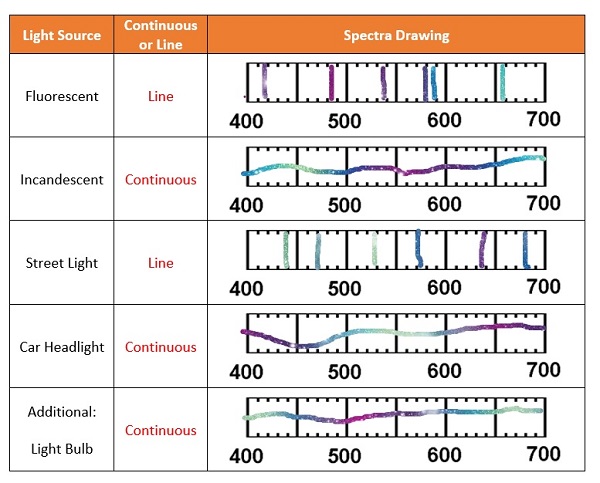SCI 155 quantitative spectroscope and visible light
Quantitative Spectroscope and Visible Light
Purpose/Question- This lab is designed to enable the students to be able to create their own light spectrum to create its’ own spectra. The students will also learn about the spectroscope to make emission spectra viewable with different light sources.
Hypothesis- If there is more light being let into the scope then the less you will be able to see the visible light.
Data Tables-

Analysis Questions-
- Hold the grating several inches from your face, at an angle. Look at the grating that you will be using. Record what details you see at the grating surface.
- The details that I can see would be the reflecting spectrum of colors that you see through the grating, I can see what is in front of me with rainbows covering it.
- Hold the diffraction grating up to your eye and look through it. Record what you see. Be specific.
- Looking through the diffraction I can see the window behind me, and a few squares of the color spectrum.
- Before mounting the diffraction grating, look through the opening that you made for your grating. Record what you see across the back of your spectroscope.
- I see the light slowly shimmering on the part where I am looking through it.
- After mounting the diffraction grating, look through your spectroscope and record what you see across the back of your spectroscope. Be specific.
- I see the different spectrum of colors in lines with the background of the spectroscope.
- Starting at the light inlet slit and going outward, what colors do you see in the spectrum? List them all.
- The colors I saw were red, orange, yellow, green, light blue, dark violet.
- When you view the spectrum, you should be able to see a spectral image to the right and left of the light inlet slit. How are the spectral images the same? How are they different? Record your findings.
- The spectral images are the same because of the colors that they produce. They are different because of the sizes of the lines you are visibly able to see.
- Try narrowing and widening the light inlet slit. How does this affect the spectra that appear? Compare the shape, thickness, and resolution of the spectral lines before and after narrowing the slit. Record your findings.
- The spectral images are different because of the length and shape of each depending on the slits. When the slit is wide, the light that is able to get in is more, so it shows more of the spectrum. While if it’s narrow slit, you will see less of the color spectrum.
- Write up to five sentences describing how a spectroscope works. Make certain to mention things like the light inlet slit, diffraction grating, light, spectrum, etc.
- A spectroscope is a device works by breaking down the light into the spectra that make it up. This device also uses diffraction grating, this uses lots of tiny little lines that are one wavelength apart. When the light hits these lines, it bends, and the different wavelengths bend making the colors appear in the visible spectrum.
- Describe the similarities and differences between the spectra of incandescent light and fluorescent light. Use your results in Data Table 1 to explain your answer.
- The difference between the two light spectrums are that Incan lines that are spread through the spectrum, while the fluorescent light has a continuous spectrum, meaning that the colors were continuous throughout the whole line.
Claim- When the light is reflected with different types of light, the spectrum of colors will change from large to smaller segments.
Evidence- When the different light sources are brought up against the grating, the spectrum can change back and forth from the different sizes and colors of the wavelengths.
Reflection- Initially I did not know that the spectrum could vary from one light source to another, and it was interesting seeing the ways that the grating could very also due to the light source and angle. Seeing the light changing was a key indicator that the properties of the light spectrum are ranged in what we see every day.
References-
Pages, Tom. Spectra of Light Sources, cholla.mmto.org/lights/spectra/.
Figure: What Does a Spectroscope Do?, amazing space.stsci.edu/resources/explorations/groundup/lesson/basics/g23/.


